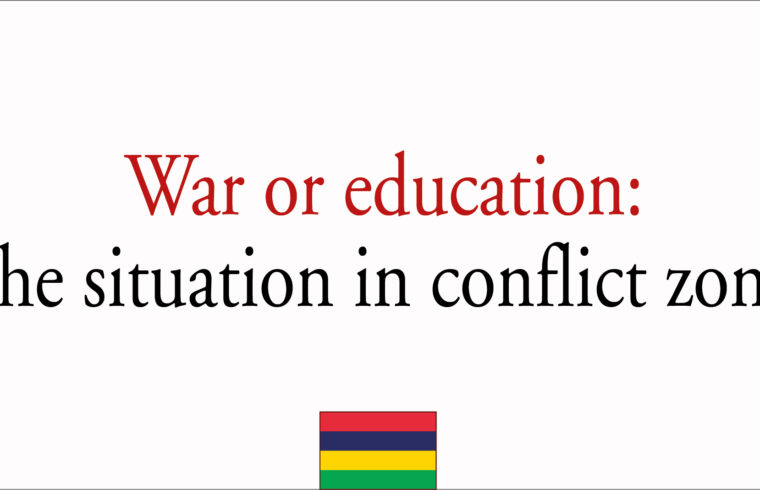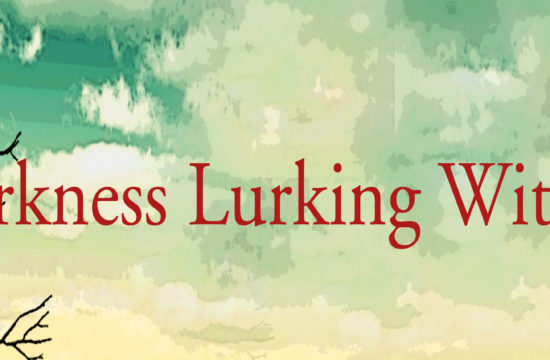Jean Eudes Agathe – MAURITIUS
“The impact of war confl icts on children is everyone’s responsibility. And it must be everyone’s concern (Garça Machel, 1996). The United Nations Children’s Fund, UNICEF, reported back in 2017 that more than 27 million children in confl ict zones were out of school. In times of peace, disparities are already a major setback for inclusive education, and in times of confl ict and war, these terrible inequities are only reinforced and perpetuated. We must ask ourselves: How and why? Is the right to education not a human right? However, in times of war, this right is overlooked as much as child’s rights. There is a serious need to fi nd an equilibrium – or even some kind of protection towards educational entities in dire times of war. The Geneva Conventions (1948) have, however, passed laws regarding actions that need to be respected during war times, but for some obscure reasons, are having diffi culties implementing them. Article 501 does clearly mention that “The Occupying Power shall, with the co-operation of the national and local authorities, facilitate the proper working of all institutions devoted to the care and education of children.” Yet, schools and /or other educational institutions are the prime targets during wars and confl icts situations, being used as garrison points for armed militia troops for either the Occupying power or the Resistance.
Getting education in confl ictual conditions is risky for children. Attack rates on schools have risen by at least 19% in the past two years2. In the ongoing confl ict between Ukraine and Russia, 20 schools are being attacked on average on a daily basis. A very alarming fi gure. Children are being deprived of a solid educational basis which results in the deprivation of necessary elementary skills, which in turn results in the incapacity of these individuals to provide for – not only for themselves, but also for the country, later on. This, ultimately, creates a generation of dependents on organisations and other countries. “The impact of armed confl ict on education creates humanitarian and development challenges and social problems”, especially inhumane child exploitation, children, so-called “soldiers.” A joint intervention from the UN and its free partners has freed a total of 12 463 „child-soldiers“. Unfortunately, the situation remains troublesome and worrying. The problem is twofold. Firstly, kidnapping; which is still a common activity in conflict zones. Then, kidnapped children are brainwashed to swell up the ranks of armed militias or exploited through child labour for minimal to non-existent wages. Another major issue is unmediated sexual crimes: a sensitive subject to address. The reasons laid behind these actions are gathered through interviews with victims but Dara Cohen expressed the need to ask the perpetrators more often. A difficult task, indeed.
From a teaching level perspective, the consequences are felt. A riskier and less “upscale” area is bound to attract less qualifi ed candidates as educators, thus, further reducing educational quality in the country. The dropout rates are higher than usual. There is an aporia. Due to attacks and the destruction of schools, there is an understandable fear from parents of losing their children combined to the lack of financial support to ensure the continuity of courses, and therefore less children are attending schools. UNICEF, despite struggles and obstacles, is financially supporting countries to attempt to even the odds, ensuring that education is somehow being delivered. The Safe Schools Declaration (2015) “outlines a set of commitments to strengthen the protection of education from attack and restrict the use of schools and universities for military purposes.” These attacks are too frequent. In real time of war and confl ict, data collection and analysis are tedious tasks to tackle. The confl ictual impacts on a country is measured in terms of years and lost lives as well as how much resources are wasted. The numerous aftermaths that remain in war victims, both on a physiological and psychological level, need to be treated and come with a great fi nancial cost. From home relocations, the number of orphans (1 child out of 4 lives in a confl ict zone) piling up in ruined buildings is a major concern. UNICEF faces restrictions on precisely locating orphans and their support for basic services. What can you do? Set up auxiliary cells to cure or cleanse children in confl ict areas? For sure! In Cameroon, for example, a situation similar to that in the Democratic Republic of Congo, political instability and war have hampered progress in education (https://www.globalgiving. org/projects/support-orphans-cameroon/).
The general situation is not new. It is seen all over the world, by analysts, NGOs, and experts. SOS Children’s Villages promotes the protection, care, and healthy development of children in difficult situations throughout the world. With the outbreak of the Syrian civil war, The United Nations (UN) participated in 2016 and was in charge of the evacuation of children from Aleppo. In 2018, a temporary crisis center was built in Damascus to serve children with urgent needs4. After all, wherever it is, position or educational policy, the solution has already been found: put the child at the center of education. Make him realize that his choices and especially his voice are being heard and considered. The task remains difficult. With the arrival of the new coronavirus, things got worse. Education is a security issue. It enables fulfillment, can reduce violence, and is useful as an instrument of peace (https://www.prio.org/ Publications/Publication/?x=11165).
Strengthening democracy and state development while reducing the number of confl icts is the goal of effective education. When will successful implementation of these guidelines be achieved? War is no longer art; it has become barbarism. The deaths of children, their over-exploitation and intentional violations of children’s and human rights have hampered the United Nations‘ goal of education for all…
Geneva Convention: Relative to the protection of civilian persons in time of war, August 1949
https://www.unicef.org/education-under-attack
https://reliefweb.int/report/ukraine/ukraine-more-20-schools-attacked-average-every-day-escalationwar#:~:text=About%2043%25%20of%20attacks%20on,besieged%20city%20of%20Kharkiv%20alone.
https://www.sosve.org/actualites/syrie-sos-villagesdenfants-ouvre-refuge-enfants-a-damas/











